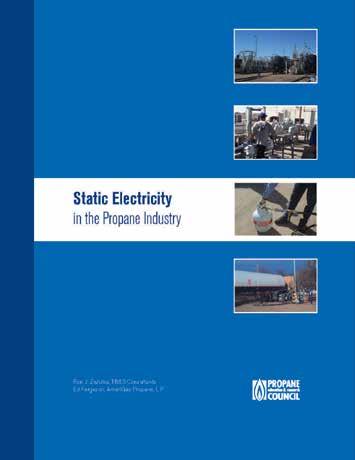
2 minute read
Static Discharge Prevention Tips Safety Meeting
Static Discharge Prevention Tips
The release of static electricity (static discharge) can be extremely hazardous in propane operations. By using the following tips, you can help prevent and control static discharge and ensure a safe working environment for yourself and your coworkers.
Advertisement
EIGHT SAFETY TIPS FOR PREVENTING STATIC DISCHARGE:
3 1. Know the area. Every propane facility has designated Static Discharge Control Areas – places where propane vapors may be released or pooled. These include areas where any propane transfer, processing, or storage occurs. Be aware of where these locations are, and take appropriate prevention measures when nearby. 3 2. Ground yourself. Workers can conduct or carry a significant amount of static electricity as they move about the plant. Always wear static-safe footwear or conductive wristbands, and use a static-safe floor or floormat to safely discharge any buildup before handling propane. 3 3. Check your attire. Cotton and cotton blends generate less static electricity than most synthetic materials, and thus are the typical propane uniform fabric. Wear your uniform and be aware of any garment or layers that “snap” or “crackle” when removing. Never put on or remove clothing inside a Static Discharge Control Area.
3 4. Clean up. Check that all HDPEs, PVCs, and other synthetic materials are out of Static Discharge Control Areas. 3 5. Follow regulatory code. Electrical equipment inside a Static Discharge Control Area must be installed in accordance with NFPA 58 and state electrical codes and regulations. Metal and non-electrical stationary equipment, such as rollers, should also be grounded. 3 6. Observe your processes. Most static electricity comes from the friction between materials, even if they are non-conductive. Review your facility’s processes and activities and take action to reduce any apparent risk. 3 7. Limit access. Limit access to Static Discharge Control Areas to trained propane workers who understand how to perform the particular task and handle static discharge safely. 3 8. Speak up. Propane personnel who work in Static Discharge Control Areas can provide the best information on potential threats and hazards. Let your supervisor know of any issues you become aware of.
DISCUSSION TOPICS
1.You have been engaged to perform a new task and believe that it may produce a significant static electricity issue. How do you respond?
2.You notice that several plastic trays and some plastic wrap are present inside a Static Discharge Control Area. You need to fill cylinders quickly for a waiting customer. What should you do?
LEARNING ACTIVITY
Stage a Static Discharge Control Area, and walk your participants through what to do when entering, working in, and leaving the area.
Source: Static Electricity in the Propane Industry (PERC)
MORE RESOURCES
More static electricity information can be found in PERC’s Static Electricity training materials:
The Propane Education & Research (PERC) has several different educational assets on static electricity including a 28-page booklet for propane providers on this exact subject that can be downloaded on PERC’s resource catalog at https://propane.com/ resource-catalog/.
There is also an interactive course on static electricity that propane retailers can take for FREE available on PERC’s online learning center at https://training.propane.com/.







